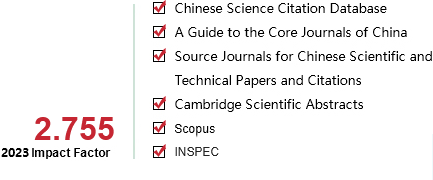[1]MU Lingxia,LI Xiao,WANG Ban,et al.Trajectory planning method based on improved sequential convex optimization algorithm for multiple UAVs[J].CAAI Transactions on Intelligent Systems,2025,20(1):128-138.[doi:10.11992/tis.202312035]
Copy
Trajectory planning method based on improved sequential convex optimization algorithm for multiple UAVs
CAAI Transactions on Intelligent Systems[ISSN 1673-4785/CN 23-1538/TP] Volume:
20
Number of periods:
2025 1
Page number:
128-138
Column:
学术论文—智能系统
Public date:
2025-01-05
- Title:
- Trajectory planning method based on improved sequential convex optimization algorithm for multiple UAVs
- Keywords:
- multiple UAVs; flight trajectory planning; obstacle avoidance constraint; sign distance function; convex optimization; adaptative feasible region; approximate convex subproblem; cooperative arrival
- CLC:
- TP273; V279
- DOI:
- 10.11992/tis.202312035
- Abstract:
- The rapid development of artificial intelligence technology in recent years has made the execution of collaborative tasks using multiple unmanned aerial vehicles (UAVs) a prominent research topic. In this study, the path planning problem for a multi-UAV cooperative arriving at a target point in a complex environment is studied. First, an optimal control problem is formulated. The non-convex obstacle avoidance constraints are addressed using the sign distance function. Then, the obstacle avoidance constraints between the discrete sequences of UAVs are considered to ensure continuous flight safety for multiple UAVs. Finally, a convex optimization algorithm for adaptive feasible region sequences is proposed, which ensures that the solution of the approximate convex problem can be found in each sequence iteration and the optimal trajectory of multiple UAVs can be quickly determined. The algorithm is suitable for a multi-UAV cooperative arriving at specific target points in an obstacle environment and has a fast convergence speed.
- References:
-
[1] 符小卫, 徐哲, 朱金冬, 等. 基于PER-MATD3的多无人机攻防对抗机动决策[J]. 航空学报, 2023, 44(7): 196-209.
FU Xiaowei, XU Zhe, ZHU Jindong, et al. Maneuvering decision-making of multi-UAV attack-defence confrontation based on PER-MATD3[J]. Acta aeronautica et astronautica sinica, 2023, 44(7): 196-209.
[2] 张磊, 李姜, 侯进永, 等. 基于改进强化学习的多无人机协同对抗算法研究[J]. 兵器装备工程学报, 2023, 44(5): 230-238.
ZHANG Lei, LI Jiang, HOU Jinyong, et al. Research on multi-UAV cooperative confrontation algorithm based on improved reinforcement learning[J]. Journal of ordnance equipment engineering, 2023, 44(5): 230-238.
[3] 武晓龙, 吴涛涛, 张震. 高端战争中低成本无人机集群作战研究[J]. 战术导弹技术, 2023(5): 157-163.
WU Xiaolong, WU Taotao, ZHANG Zhen. Low-cost UAVs operational network in high-end warfare[J]. Tactical missile technology, 2023(5): 157-163.
[4] 李望西, 王勇, 吴文超, 等. 面向空空作战的有人/无人机协同作战模式研究[J]. 无人系统技术, 2023, 6(4): 76-84.
LI Wangxi, WANG Yong, WU Wenchao, et al. Research on manned/unmanned air vehicle cooperative combat model for air-to-air combat[J]. Unmanned systems technology, 2023, 6(4): 76-84.
[5] 俞宬, 陈谋, 雍可南. 基于改进RRT*算法的无人机往返航迹规划[J]. 中国科学: 技术科学, 2023, 53(11): 1911-1921.
YU Cheng, CHEN Mou, YONG Kenan. Round-trip path planning for unmanned aerial vehicle based on improved RRT* algorithm[J]. Scientia sinica (technologica), 2023, 53(11): 1911-1921.
[6] DU Yuwen. Multi-UAV search and rescue with enhanced A* algorithm path planning in 3D environment[J]. International journal of aerospace engineering, 2023, 2023(7): 8614117.
[7] FU Jinyu, SUN Guanghui, YAO Weiran, et al. On trajectory homotopy to explore and penetrate dynamically of multi-UAV[J]. IEEE transactions on intelligent transportation systems, 2022, 23(12): 24008-24019.
[8] 张堃, 刘泽坤, 华帅, 等. 基于T/S-SAS的多无人机四维协同攻击航线生成[J]. 兵工学报, 2023, 44(6): 1576-1587.
ZHANG Kun, LIU Zekun, HUA Shuai, et al. Generation of multi-UAV four-dimensional cooperative attack route based on T/S-SAS[J]. Acta armamentarii, 2023, 44(6): 1576-1587.
[9] 赵飞虎, 李哲, 王宁, 等. 面向战场的多无人机协同打击航迹规划[J]. 电光与控制, 2023, 30(9): 9-14,91.
ZHAO Feihu, LI Zhe, WANG Ning, et al. Path planning for multi-UAV cooperative strike in battlefield environments[J]. Electronics optics & control, 2023, 30(9): 9-14,91.
[10] LI Shouyi, CHEN Mou, WANG Yuhui, et al. A fast algorithm to solve large-scale matrix games based on dimensionality reduction and its application in multiple unmanned combat air vehicles attack-defense decision-making[J]. Information sciences, 2022, 594: 305-321.
[11] 刘哲, 贾生伟, 张鸣, 等. 再入轨迹多约束模型预测静态凸规划方法[J]. 宇航学报, 2022, 43(12): 1638-1651.
LIU Zhe, JIA Shengwei, ZHANG Ming, et al. Reentry trajectory optimization based on constrained model predictive static convex programming[J]. Journal of astronautics, 2022, 43(12): 1638-1651.
[12] 安泽, 熊芬芬, 梁卓楠. 基于偏置比例导引与凸优化的火箭垂直着陆制导[J]. 航空学报, 2020, 41(5): 247-260.
AN Ze, XIONG Fenfen, LIANG Zhuonan. Landing-phase guidance of rocket using bias proportional guidance and convex optimization[J]. Acta aeronautica et astronautica sinica, 2020, 41(5): 247-260.
[13] 姜欢. 凸优化方法在导弹轨迹优化与制导控制中的应用[D]. 北京: 北京理工大学, 2017.
JIANG Huan. Application convex optimization theory in trajectory optimization, guidance and control of missile[D]. Beijing: Beijing Institute of Technology, 2017.
[14] 刘玉杰, 李樾, 韩维, 等. 基于改进凸优化算法的多机编队突防航迹规划[J]. 系统工程与电子技术, 2023, 45(9): 2819-2830.
LIU Yujie, LI Yue, HAN Wei, et al. Trajectory planning for penetration of multi-aircraft for mation based on improved convex optimization algorithm[J]. Systems engineering and electronics, 2023, 45(9): 2819-2830.
[15] AUGUGLIARO F, SCHOELLIG A P, D’ANDREA R. Generation of collision-free trajectories for a quadrocopter fleet: a sequential convex programming approach[C]//2012 IEEE/RSJ International Conference on Intelligent Robots and Systems. Vilamoura-Algarve: IEEE, 2012: 1917-1922.
[16] 徐广通, 王祝, 曹严, 等. 动态优先级解耦的无人机集群轨迹分布式序列凸规划[J]. 航空学报, 2022, 43(2): 420-431.
XU Guangtong, WANG Zhu, CAO Yan, et al. Dynamic-priority-decoupled UAV swarm trajectory planning using distributed sequential convex programming[J]. Acta aeronautica et astronautica sinica, 2022, 43(2): 420-431.
[17] VIRGILI-LLOP J, ZAGARIS C, ZAPPULLA R, et al. Convex optimization for proximity maneuvering of a spacecraft with a robotic manipulator[C]//27th AAS/AIAA Space Flight Mechanics Meeting. San Antonio: AAS, 2017: 1059-1078.
[18] 王祝, 刘莉, 龙腾, 等. 基于罚函数序列凸规划的多无人机轨迹规划[J]. 航空学报, 2016, 37(10): 3149-3158.
WANG Zhu, LIU Li, LONG Teng, et al. Trajectory planning for multi-UAVs using penalty sequential convex pro-gramming[J]. Acta aeronautica et astronautica sinica, 2016, 37(10): 3149-3158.
[19] ZHAO Feng, YU Jianglong, HUA Yongzhao, et al. Decoupled SCP-based trajectory planning in the complex environment for multiple fixed-wing UAV systems[C]//2022 International Conference on Unmanned Aircraft Systems. Dubrovnik: IEEE, 2022: 670-675.
[20] MA Yangyang, PAN Binfeng, YAN Rui. Feasible sequential convex programming with inexact restoration for multistage ascent trajectory optimization[J]. IEEE transactions on aerospace and electronic systems, 2023, 59(2): 1217-1230.
[21] 李征, 陈建伟, 彭博. 基于伪谱法的无人机集群飞行路径规划[J]. 空天防御, 2021, 4(1): 52-59.
LI Zheng, CHEN Jianwei, PENG Bo. UAV cluster path planning based on pseudo-spectral method[J]. Air & space defense, 2021, 4(1): 52-59.
[22] PATTERSON M A, RAO A V. GPOPS-II: a Matlab software for solving multiple-phase optimal control problems using hp-Adaptive Gaussian quadrature collocation methods and sparse nonlinear programming[J]. ACM transactions on mathematical software, 2014, 41(1): 1-37.
- Similar References:
Memo
-
Last Update:
2025-01-05
